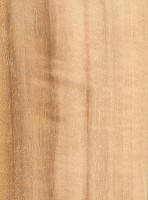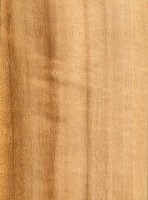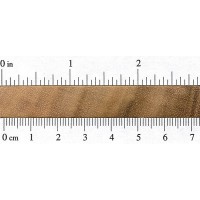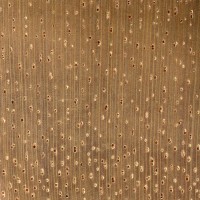 |
Common Name(s): Queensland Maple Scientific Name: Flindersia spp. (F. brayleyana) Distribution: Northern Queensland (Australia) Tree Size: 100 ft (30 m) tall, 3 ft (1 m) trunk diameter Average Dried Weight: 35 lbs/ft3 (560 kg/m3) Specific Gravity (Basic, 12% MC): .45, .56 Janka Hardness: 810 lbf (3,620 N) Modulus of Rupture: 11,750 lbf/in2 (81.0 MPa) Elastic Modulus: 1,570,000 lbf/in2 (10.83 GPa) Crushing Strength: 6,810 lbf/in2 (47.0 MPa) Shrinkage: Radial: 6.1%, Tangential: 8.8%, Volumetric: 15.0%, T/R Ratio: 1.4 |
Color/Appearance: Heartwood ranges from yellow to golden or reddish brown, darkening with age. Narrow white sapwood is differentiated from heartwood.
Grain/Texture: Grain is interlocked and sometimes wavy. Texture medium to coarse with a good natural luster. (The wood is also sometimes referred to as “silkwood” because of its luster.)
Endgrain: Diffuse-porous; medium to large pores in no specific arrangement, few; solitary and radial multiples of 2-3; heartwood mineral/gum deposits occasionally present; growth rings indistinct; medium to large rays may be just barely visible without lens, spacing wide; depending on species, parenchyma may be banded, or not visible at all.
Rot Resistance: Rated as non-durable regarding decay-resistance, with mixed resistance to various insect attacks.
Workability: Overall good working characteristics, though because of the interlocked grain, planing may result in tearout, particularly on quartersawn surfaces. Turns, glues, and finishes well.
Odor: Queensland Maple can have a distinct odor while being worked, particular when the wood is still green.
Allergies/Toxicity: Although severe reactions are quite uncommon, Queensland Maple has been reported to cause skin and respiratory irritation. See the articles Wood Allergies and Toxicity and Wood Dust Safety for more information.
Pricing/Availability: Seldom available in the United States, though prices are likely to be moderate for an imported Australian timber.
Sustainability: This wood species is not listed in the CITES Appendices or on the IUCN Red List of Threatened Species.
Common Uses: Furniture, cabinetry, veneer, musical instruments, gunstocks, and turned objects.
Comments: Although named Queensland Maple, this wood is not a true maple (Acer genus), but is instead contained in the Rutaceae family, which also contains many genera and species in the citrus family.
None available.
None available.







